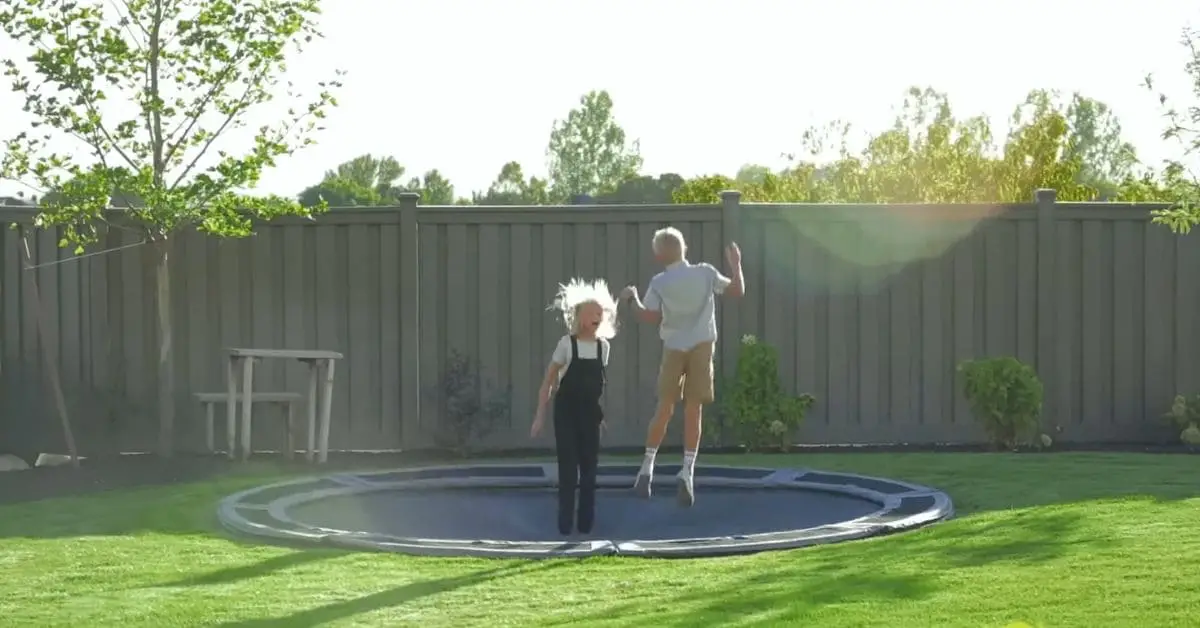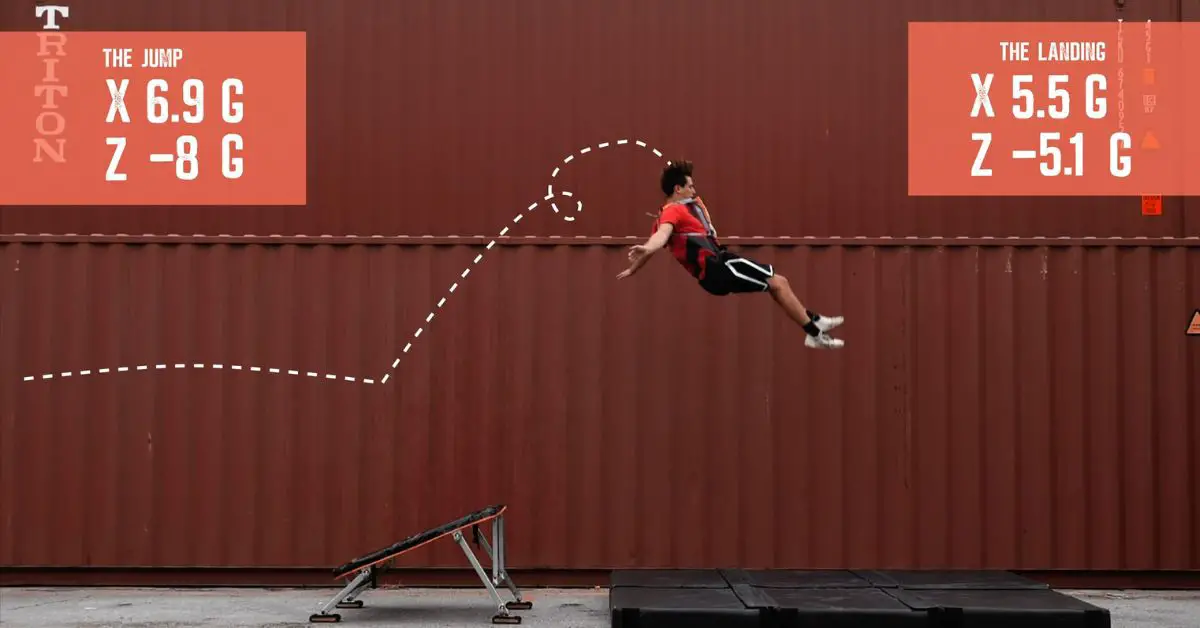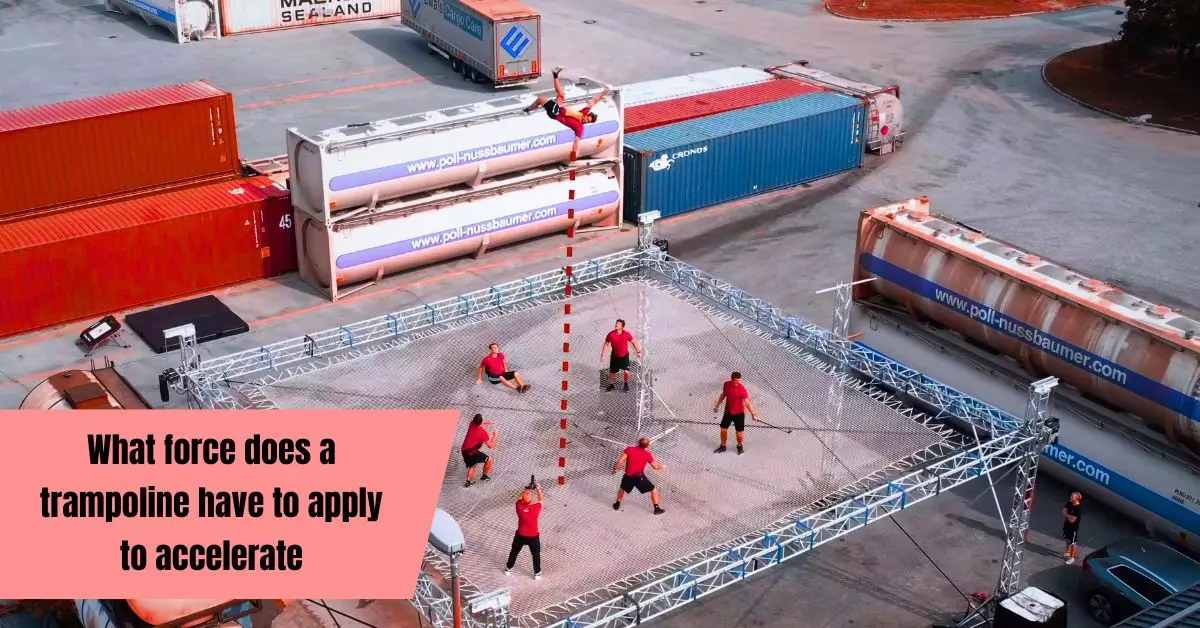Do you know “Force Required for Trampoline Acceleration?” When I jump on a trampoline, the force needed to accelerate me upward is generated by the compression and release of the trampoline’s surface.
According to Newton’s second law of motion, the force applied is directly related to my weight and the desired upward acceleration. The elasticity and tension of the trampoline surface also play a crucial role.
A more elastic surface can produce a greater force, leading to higher acceleration. Additionally, the angle and velocity of my jump impact the force applied. A steeper angle and higher velocity result in a stronger upward force.
It’s important to consider that multiple users jumping simultaneously can affect the force distribution and dynamics of the trampoline. Understanding these forces is vital for safety, performance optimization, and an enjoyable bouncing experience.
Force Required for Trampoline Acceleration: The force required to accelerate a 45.0-kg gymnast straight up at 7.50 m/s² on a trampoline is calculated using Newton’s second law of motion.
The Concept of Force and Acceleration

The concept of force and acceleration is fundamental in understanding the relationship between the motion of objects and the forces acting upon them.
Definition of Force and Acceleration:
- Force: A push or pull that can cause an object to change its motion or shape.
- Acceleration: The rate at which an object’s velocity changes over time.
Newton’s Second Law of Motion and its Relevance to Trampolines:
- Newton’s second law states that the force acting on an object is directly proportional to its mass and acceleration.
- In the case of trampolines, this law helps explain the forces involved in bouncing and how they relate to the mass and acceleration of the user.
Relationship Between Force, Mass, and Acceleration:
- Force = mass × acceleration (F = m × a)
- The force applied to an object is directly proportional to its mass and the acceleration it experiences.
- In the context of trampolines, the force exerted on the surface depends on the mass of the user and the acceleration they experience while bouncing.
Understanding the concepts of force and acceleration, as well as their relationship to mass, is essential for comprehending the physics behind trampolines and how they affect the movements of users on the surface.
Factors Influencing the Force Applied on a Trampoline
Here are several factors influencing the force applied on a trampoline:
User’s Weight and Mass:
- The weight and mass of the user directly impact the force exerted on the trampoline.
- Heavier users apply a greater force due to their increased mass, resulting in higher compression of the trampoline surface.
- The force applied is proportional to the user’s weight according to Newton’s second law of motion.
Elasticity and Tension of the Trampoline Surface:
- The elasticity and tension of the trampoline surface affect the force applied.
- A more elastic surface can generate greater resistance and force during compression and release.
- The tension in the trampoline surface contributes to the overall force by providing a restoring force as the surface deforms and rebounds.
Angle and Velocity of the Jump:
- The angle and velocity at which the user jumps influence the force applied.
- A steeper jump angle and higher velocity result in a stronger force exerted on the trampoline surface.
- The force increases as the user’s upward velocity and angle of ascent become greater.
Impact of Multiple Users on the Trampoline:
- The presence of multiple users simultaneously jumping on the trampoline affects the force distribution.
- The combined forces from each user can impact the overall compression and dynamics of the trampoline surface.
- The force exerted by each user interacts with the forces from other users, potentially leading to changes in the trampoline’s behavior and response.
Understanding these factors is crucial for assessing the forces involved in trampoline use. It helps in ensuring user safety and optimizing the performance of the trampoline.
By considering the user’s weight, the properties of the trampoline surface (elasticity and tension), the technique of jumping, and the potential interaction between multiple users, one can gain a better understanding of the forces at play and effectively manage them.
Measuring the Force Applied on a Trampoline

Measuring the force applied on a trampoline involves the use of specific instruments and techniques to obtain accurate data.
Here are some key points regarding the measurement of force on a trampoline:
Instruments and Techniques for Force Measurement:
- Force sensors: Specialized sensors, such as load cells or strain gauges, can be attached to various components of the trampoline to measure the forces acting on them.
- Force plates: These are devices installed beneath the trampoline surface to measure the forces applied by users during jumps. Force plates can provide detailed data on the magnitude and distribution of forces.
- Accelerometers: These sensors can measure the rate of change of velocity or acceleration experienced by the trampoline or users. They can indirectly provide information about the forces involved.
Examples of Studies and Experiments on Trampoline Force Measurement:
- Researchers use force sensors or force plates to measure the impact forces exerted on the trampoline surface during jumps.
- Studies may involve collecting data from multiple users of varying weights and jump techniques to analyze the forces applied.
- Force measurements can help evaluate the performance of different trampoline designs and materials and assess their safety in real-world scenarios.
Accurate measurement of forces on a trampoline provides valuable insights for understanding its behavior, performance, and safety.
By employing specialized instruments and techniques, researchers and engineers can gather data to enhance the design, optimize user experiences, and ensure the appropriate use of trampolines.
Impact of Force on Trampoline Safety and Performance
The force exerted on a trampoline has a significant impact on both its safety and performance. Here are key points highlighting the effects of force on trampolines:
Understanding Safe Weight Limits and Load Capacity:
- Excessive force from users exceeding the weight limit of the trampoline can lead to structural damage or failure.
- Manufacturers provide weight limits for trampolines to ensure safe usage and prevent accidents.
Importance of Maintaining the Trampoline’s Structural Integrity:
- High forces exerted on the trampoline, especially during intense jumps, can strain the frame, springs, and other components.
- Regular maintenance and inspections are necessary to identify any signs of wear and tear, ensuring the trampoline remains safe for use.
Mitigating Risks of Excessive Force and Injury Prevention:
- Excessive force can increase the risk of users bouncing off the trampoline or landing improperly, leading to injuries.
- Proper supervision, adherence to safety guidelines, and user education on jump techniques can minimize the chances of accidents caused by excessive force.
Understanding the impact of force on trampoline safety and performance is crucial for both users and manufacturers.
By staying within weight limits, maintaining structural integrity, and implementing safety measures, the risks associated with excessive force can be mitigated, ensuring a safer and more enjoyable trampolining experience.
Strategies to Modify Force and Acceleration on a Trampoline
Strategies to modify force and acceleration on a trampoline involve making adjustments to various factors that affect the intensity of jumps and the resulting forces. Here are some effective strategies to consider:
Adjusting User Techniques and Body Positions:
- Encourage users to bend their knees upon landing: This technique helps absorb and distribute the force more evenly throughout the body, reducing the impact on specific joints and muscles.
- Teach users to maintain proper body control and balance: By learning how to control their movements and maintain balance, users can minimize erratic motions that can increase the force exerted on the trampoline. This includes keeping the body aligned and centered while jumping.
Altering Trampoline Design Elements for Desired Force and Acceleration:
- Adjust the tension of the trampoline surface: By tightening or loosening the springs, you can modify the tension of the trampoline surface. Tighter springs result in a higher level of bounce and force, while looser springs provide a softer bounce with less force.
- Use trampolines with adjustable springs or tension settings: Some trampolines offer adjustable springs or tension settings, allowing you to customize the force and acceleration according to individual preferences.
This feature can be particularly useful when accommodating users with varying ages, sizes, and skill levels.
Implementing Safety Measures to Control Excessive Force:
- Install safety enclosures or nets: Safety enclosures or nets around the trampoline create a protective barrier, preventing users from bouncing off and experiencing excessive force upon impact. They provide an added layer of safety by keeping users within the trampoline’s boundaries.
- Limit the number of users on the trampoline: Overcrowding the trampoline can increase the forces generated during jumps and heighten the risk of collisions.
Limiting the number of users at a given time ensures a safer environment and reduces the likelihood of accidents caused by excessive force.
By implementing these strategies, users can modify the force and acceleration on a trampoline to achieve the desired level of intensity while maintaining safety.
It is important to strike a balance between the thrill of jumping and responsible usage by following safety guidelines and supervising trampoline activities, especially when children are involved.
What Force Does a Trampoline Have to Apply to Accelerate: Safety Considerations

When considering the force that a trampoline needs to apply to accelerate users, it is essential to prioritize safety. Here are some safety considerations related to trampoline force:
Importance of Proper Supervision and User Guidelines:
- Supervision: Trampoline usage should always be supervised, especially when children are involved. An adult should be present to ensure safe practices and intervene if necessary.
- User Guidelines: Clear and comprehensive guidelines should be provided to users, highlighting safe jumping techniques, proper landing positions, and rules for avoiding risky behaviors.
Recommended Safety Equipment for Trampoline Use:
- Safety Enclosure: A trampoline should ideally be equipped with a safety enclosure or netting system to prevent users from bouncing off the trampoline surface and falling.
- Padding and Covers: Ensure the presence of safety pads and spring covers to minimize the risk of impact injuries and reduce the force exerted on users’ bodies during jumps.
- Non-Slip Surface: A non-slip surface on the trampoline mat helps users maintain traction and stability while jumping, reducing the likelihood of slips and falls.
Educating Users about Safe Jumping Techniques and Landing Positions:
- Bend the Knees: Users should be advised to bend their knees upon landing to absorb the impact and distribute the force more evenly throughout their bodies.
- Controlled Movements: Encourage users to maintain control and avoid erratic movements, as uncontrolled or reckless bouncing can lead to higher forces and an increased risk of injury.
- Appropriate Landing Positions: Teach users to land with their feet centered and slightly apart to maintain balance and stability. Landing on the balls of the feet helps absorb the force and prevents jarring impacts on the joints.
By emphasizing proper supervision, providing clear user guidelines, recommending safety equipment, and educating users about safe jumping techniques and landing positions, the force applied by a trampoline to accelerate can be managed in a way that prioritizes safety and reduces the risk of accidents or injuries.
Impact of Environmental Factors on Trampoline Force and Acceleration
Environmental factors can significantly impact trampoline force and acceleration. Here are some key considerations:
Temperature and Weather Conditions:
- Temperature: Extreme temperatures, whether too hot or too cold, can affect the elasticity and performance of the trampoline mat. Cold temperatures can make the mat more rigid and less bouncy, while hot temperatures can make it more elastic and bouncier.
- Humidity: High humidity levels can reduce the elasticity of the trampoline surface, resulting in less force and lower acceleration during jumps. Conversely, low humidity can increase the bounce and force exerted on the trampoline.
Surface Stability:
- Ground Surface: The stability and evenness of the ground underneath the trampoline can influence the force and acceleration. Uneven or soft ground may cause uneven forces and impact the trampoline’s performance.
- Grass Conditions: Wet grass can make the trampoline surface slippery, potentially reducing traction and affecting the force applied during jumps.
Wind:
- Wind Resistance: Wind can impact the trampoline by creating resistance against the user’s movements, making it more challenging to generate force and accelerate.
- Wind Gusts: Strong wind gusts can create unpredictable forces on the trampoline, affecting stability and potentially increasing the risk of tipping over or causing uncontrolled movements.
Understanding and accounting for these environmental factors is crucial for ensuring safe and optimal trampoline usage. Users should consider the weather conditions, surface stability, and wind conditions before engaging in trampoline activities.
Adapting to these factors can help maintain a consistent and safe trampoline experience while managing force and acceleration effectively.
The Role of Trampoline Springs in Force and Acceleration
The springs of a trampoline play a significant role in determining the force and acceleration experienced during jumps. Here’s how trampoline springs influence these factors:
Function and Characteristics of Trampoline Springs:

- Trampoline springs are elastic components that connect the jumping mat to the frame.
- Their primary function is to store and release energy to create the bouncing effect.
- Springs are typically made of steel and come in various lengths and designs.
Relationship Between Spring Tension and Bounce Height:
- The tension or tightness of trampoline springs affects the bounce height.
- Higher spring tension results in greater potential energy storage and, consequently, higher bounce height.
- Adjusting the spring tension can be done by tightening or loosening the springs or using different tension settings.
Maintenance and Replacement of Trampoline Springs for Optimal Performance:
- Regular maintenance is essential to ensure the springs are in good condition.
- Inspect the springs for signs of damage, rust, or wear, and replace any faulty springs promptly.
- Proper lubrication of the springs can help maintain their elasticity and prevent premature wear.
- Follow the manufacturer’s guidelines for spring replacement and consult a professional if needed.
Understanding the function and characteristics of trampoline springs is crucial for optimizing the force and acceleration experienced during jumps.
Adjusting spring tension and properly maintaining the springs will help achieve the desired bounce height and ensure safe and enjoyable trampoline usage.
Regular inspection and replacement of worn-out springs are essential for maintaining optimal performance and preventing accidents.
Advanced Considerations for Force and Acceleration in Professional Trampolines
Here are advanced considerations for force and acceleration in professional trampolines:
Training Techniques for Achieving Greater Height and Complexity in Jumps:
- Professional trampolines require specialized training techniques to maximize force and acceleration.
- Athletes learn advanced jumping techniques, such as using precise body positioning and timing, to generate greater upward force.
- Complex maneuvers, like flips and twists, require proper technique and body control to optimize acceleration.
Engineering and Design Advancements in Professional Trampolines:
- Professional trampolines undergo continuous engineering and design improvements to enhance force and acceleration.
- Innovations in spring technology, frame construction, and jumping mat materials contribute to increased force generation.
- Professional trampolines may feature larger surface areas and higher spring tension to amplify the forces experienced by athletes.
Safety Measures Specific to Professional Trampoline Use:
- Professional trampolines require stringent safety protocols to mitigate the risks associated with high forces and accelerations.
- Safety measures may include padded surfaces, safety enclosures, and strict guidelines for athlete behavior.
- Regular inspections and maintenance of the trampoline equipment are essential to ensure structural integrity and prevent accidents.
By incorporating specialized training techniques, engineering advancements, and targeted safety measures, professional trampolines create an environment that facilitates greater force and acceleration.
These advanced considerations enable athletes to push their limits while maintaining safety and optimizing performance.
Future Research and Development in Trampoline Force and Acceleration

Here we discussed future research and development in trampoline force and acceleration:
Areas for Further Exploration and Experimentation:
- Investigating the effects of different trampoline designs, such as varying spring configurations or surface materials, on force and acceleration.
- Exploring the impact of user characteristics, such as body composition, flexibility, and skill level, on force generation and acceleration.
- Studying the influence of environmental factors, such as temperature and humidity, on trampoline performance and force dynamics.
Advancements in Force Measurement Technology for Trampolines:
- Developing more sophisticated and non-intrusive methods for accurately measuring forces and accelerations on trampolines.
- Exploring the integration of wearable sensors or motion tracking systems to capture real-time force and acceleration data during trampoline use.
- Enhancing data analysis techniques to extract valuable insights from force measurement data and identify patterns or trends.
Collaborative Efforts Between Researchers, Engineers, and Manufacturers:
- Encouraging collaboration between academia, industry, and trampoline manufacturers to drive research and development in force and acceleration.
- Sharing knowledge and expertise to enhance trampoline safety, performance, and user experience.
- Collaborative initiatives can involve conducting joint studies, exchanging data and findings, and jointly developing innovative solutions to improve the force and acceleration characteristics of trampolines.
By exploring these areas and fostering collaboration, future research, and development can lead to advancements in understanding trampoline force and acceleration.
These efforts can contribute to the development of safer, more efficient, and enjoyable trampoline experiences for users of all ages and skill levels.
FAQs About Force Required for Trampoline Acceleration
Q:1 How does a trampoline exert force?
When you jump on a trampoline, your motion can be explained by two main components: free fall and harmonic motion. When you’re in the air, the only force acting on you is gravity, pulling you downwards.
However, when you make contact with the trampoline bed, you experience a strong upward force from the trampoline itself. This combination of forces allows you to bounce and move up and down on the trampoline.
Q:2 How does Newton’s third law relate to trampolines?
Newton’s third law states that every action has an equal and opposite reaction. This law applies to trampolines and explains why you can bounce on them.
When you push down on the trampoline or land on its surface, the trampoline pushes back with an equal force in the opposite direction, causing you to bounce upwards. So, the harder you push or land on the trampoline, the stronger the upward reaction force, resulting in a higher bounce.
Q:3 What is the reaction force when jumping on a trampoline?
According to Isaac Newton’s third law of motion, every action has an equal and opposite reaction. When you jump down on the trampoline, the springs underneath push back with the same amount of force in the opposite direction.
This causes you to bounce back up into the air. The force from the springs counteracts the force of your jump, resulting in the bouncing motion. So, the stronger you jump, the stronger the springs push back, propelling you higher into the air.
Q:4 How is the force of trampoline springs generated?
The force of trampoline springs is generated through their elasticity. When compressed, the springs store potential energy, which is then released upon decompression, propelling the jumper upwards.
Q:5 What are the underlying physics principles of a trampoline?
As you jump on the trampoline, the energy you have from your movement is converted into different forms. When you rise into the air, your kinetic energy turns into potential energy. As you come back down, that potential energy is converted back into kinetic energy.
The trampoline and bungee work together to enhance your jumping power and provide stability during the jump. This allows you to stay in the air for a longer time and reach higher heights.
The combination of the trampoline’s springiness and the bungees’ elasticity helps maximize your jumping performance.
Q:6 What is the acceleration experienced at the peak of a jump on a trampoline?
When you reach the highest point of your jump on a trampoline, the acceleration you experience is equal to the acceleration due to gravity, which is approximately 9.81 meters per second squared (9.81 m/s^2).
At this point, all of the energy you have is in the form of potential energy, which means it is stored energy ready to be released when you start descending.
Q:7 How does Newton’s third law relate to the concept of acceleration?
Newton’s third law states that when two objects interact, they exert equal and opposite forces on each other. This means that the forces involved have the same strength but act in opposite directions.
However, it’s important to note that even though the forces are equal, the resulting accelerations of the objects can be different. In other words, the objects may not accelerate at the same rate even though the forces they exert on each other are balanced.
Conclusion:
In conclusion, the force that a trampoline must apply to accelerate depends on various factors. The weight and mass of the user, the elasticity and tension of the trampoline surface, and the angle and velocity of the jump all influence the force applied.
Understanding these factors is crucial for assessing the forces involved in trampoline use and ensuring safety.
Trampoline force and acceleration can be modified through strategies such as adjusting user techniques and body positions, altering trampoline design elements, and implementing safety measures.
By promoting proper jumping techniques, maintaining trampoline components, and educating users about safety guidelines, the risk of excessive force and potential injuries can be mitigated.
Further research and development in the field of trampoline force and acceleration can lead to advancements in technology, measurement techniques, and safety measures.
Collaboration between researchers, engineers, and manufacturers is vital for advancing our understanding and improving the performance and safety of trampolines.
By considering the forces at play and implementing appropriate measures, trampolines can provide enjoyable and thrilling experiences while ensuring the well-being of users. It is essential to balance excitement with responsible usage and prioritizing safety at all times.
We hope you will be well aware of “Force Required for Trampoline Acceleration”, after reading this comprehensive article. If you have any questions, feel free to comment below!

